purchace Aurogra online 15 February 2016
Cancer the Crayfish
can i buy prednisolone over the counter in uk The zodiac symbol for Cancer in the Voynich Manuscript is odd in a number of ways, but not in the ways I originally thought.
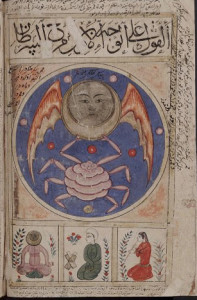 Cancer is drawn as a crab in most Mediterranean areas (left), as well as in much of England (possibly due to the abundance of salt water and crabs) but was often depicted as a crayfish, as well, particularly in regions away from the coast, so Cancer as a crayfish is not unusual, but the VMS crayfish has some strange quirks that might not be immediately apparent.
Cancer is drawn as a crab in most Mediterranean areas (left), as well as in much of England (possibly due to the abundance of salt water and crabs) but was often depicted as a crayfish, as well, particularly in regions away from the coast, so Cancer as a crayfish is not unusual, but the VMS crayfish has some strange quirks that might not be immediately apparent.
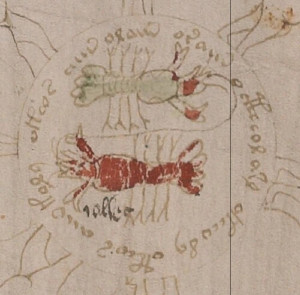 To begin with, there are two critters, not one. I’ve never seen a medieval Cancer symbol presented as a double image, with each crayfish facing in a different direction. Pisces is usually drawn this way, but not Cancer. Also, the line connecting their mouths is typical of Pisces, not of Cancer. Something unusual is going on.
To begin with, there are two critters, not one. I’ve never seen a medieval Cancer symbol presented as a double image, with each crayfish facing in a different direction. Pisces is usually drawn this way, but not Cancer. Also, the line connecting their mouths is typical of Pisces, not of Cancer. Something unusual is going on.
The Anatomy of Crayfish
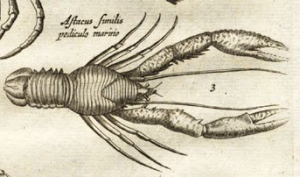 When I first saw it, the VMS crayfish looked unrealistic to me—skinny legs, tiny claws. I thought all crayfish and lobsters had fat hunky claws. Apparently not.
When I first saw it, the VMS crayfish looked unrealistic to me—skinny legs, tiny claws. I thought all crayfish and lobsters had fat hunky claws. Apparently not.
After some research, I learned that there are crayfish with slender legs and small claws. I also discovered the claws of the female are sometimes smaller than the male.
Skinny-limbed crayfish don’t live in one particular region. They range from Korea to the Caribbean and probably beyond, so the skinny limbs don’t help pinpoint the geography.
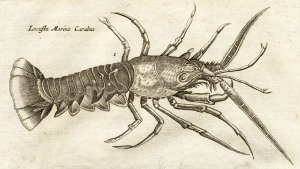 Nature is endlessly creative and the patterns on the backs of crayfish are quite varied. Some are like helmets, others have bands, some connect over the top in two layers.
Nature is endlessly creative and the patterns on the backs of crayfish are quite varied. Some are like helmets, others have bands, some connect over the top in two layers.
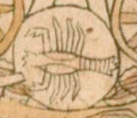 Zodiac crayfish are sometimes drawn with two C-shapes mirroring one another on their backs, a pattern that is also found in nature. There are some where the C-shapes connect over the top and others, like the drawing on the right, that don’t connect. From the side, they look like a piece of armor protecting the shoulder. The VMS crayfish appears to have a smaller version of this detail.
Zodiac crayfish are sometimes drawn with two C-shapes mirroring one another on their backs, a pattern that is also found in nature. There are some where the C-shapes connect over the top and others, like the drawing on the right, that don’t connect. From the side, they look like a piece of armor protecting the shoulder. The VMS crayfish appears to have a smaller version of this detail.
From Life or From Manuscript Tradition?
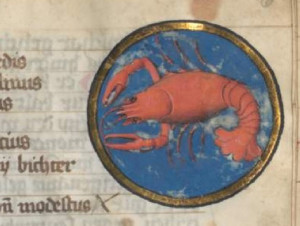 I wondered whether the VMS illustrator got the ideas for the zodiac by looking at a real crayfish or at other drawings. The upper one is green, the lower is red. Green or a greenish-gray is a common color for crayfish. When they are cooked, they turn bright red like lobsters, so the colors don’t provide many hints to the origin of the VMS. But that’s when I noticed the VMS crayfish was anatomically incorrect.
I wondered whether the VMS illustrator got the ideas for the zodiac by looking at a real crayfish or at other drawings. The upper one is green, the lower is red. Green or a greenish-gray is a common color for crayfish. When they are cooked, they turn bright red like lobsters, so the colors don’t provide many hints to the origin of the VMS. But that’s when I noticed the VMS crayfish was anatomically incorrect.
I was so distracted by the double image, the skinny legs and claws, and the line connecting the mouths that I overlooked a rather glaring defect—the VMS crayfish legs are attached to the tail! This unbalanced crayfish would have a hard time getting around. Given this anomaly, it seems unlikely that a real crayfish modeled for the VMS. Whoever drew it probably took the concept from other drawings and may have drawn it imperfectly from memory, since other Cancer symbols (at least those similar to the VMS) aren’t drawn this way.
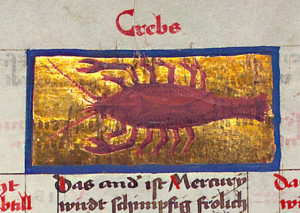 Almost all the medieval zodiacs I found that were similar to the VMS (slender limbs plus C-shape backs) were Lombardic and Frankish and were typically green or red. I haven’t had a chance to map them yet, and the overall impression may change when I do, but it’s true of the ones I’ve found so far.
Almost all the medieval zodiacs I found that were similar to the VMS (slender limbs plus C-shape backs) were Lombardic and Frankish and were typically green or red. I haven’t had a chance to map them yet, and the overall impression may change when I do, but it’s true of the ones I’ve found so far.
Summary
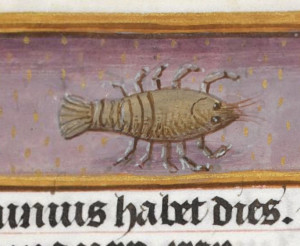 The VMS zodiac animals, such as the ram and bull, don’t seem to be drawn from life. They’re reasonably well done but, like the crayfish, they have some anatomical oddities. It seems likely they were inspired by other manuscripts—they follow the general format and style of the time. But there’s also a certain individuality to them. Enclosing the zodiac in a ring is very typical, but combining two crayfish in the same circle is quite unusual.
The VMS zodiac animals, such as the ram and bull, don’t seem to be drawn from life. They’re reasonably well done but, like the crayfish, they have some anatomical oddities. It seems likely they were inspired by other manuscripts—they follow the general format and style of the time. But there’s also a certain individuality to them. Enclosing the zodiac in a ring is very typical, but combining two crayfish in the same circle is quite unusual.
If the drawings were done from memory, then perhaps it wasn’t easy for the illustrator to copy directly from manuscripts (assuming the VMS author even wanted to do that). In the Middle Ages, the main repositories for manuscripts were libraries: ecclesiastical, university, and the personal libraries of the nobility. Some were probably housed by commercial calligraphy and illustration services, as well. Books were entirely handcrafted and, as such, were rare and expensive. Many books in libraries were chained to prevent theft—they could only be seen during viewing hours.
The VMS depiction of Cancer leaves many unanswered questions. Why two symbols? Why the line connecting two crayfish? Why is one green (with red highlights) and the other red? Why such diminutive C-shapes, compared to other zodiacs, and the ultra-skinny legs? Why are the C-shapes drawn so much smaller than other zodiacs?
Is the crayfish quirky because it was drawn from memory, or is it different because the VMS illustrator had a unique way of doing things?
Posted by J.K. Petersen
© Copyright 2016 J.K. Petersen, All Rights Reserved

